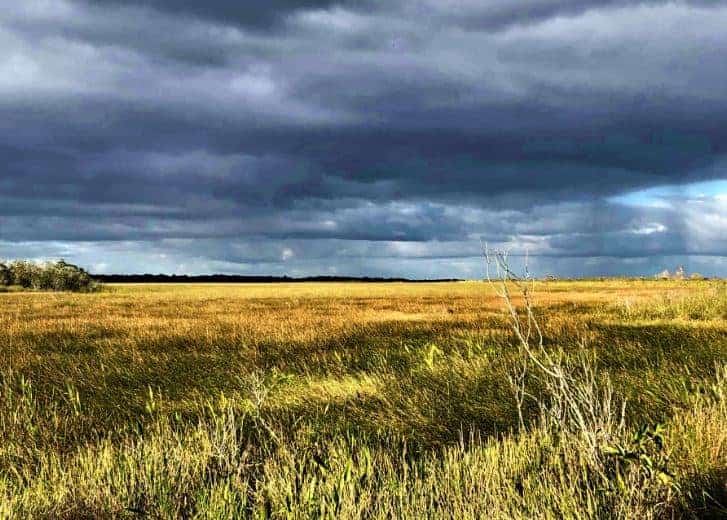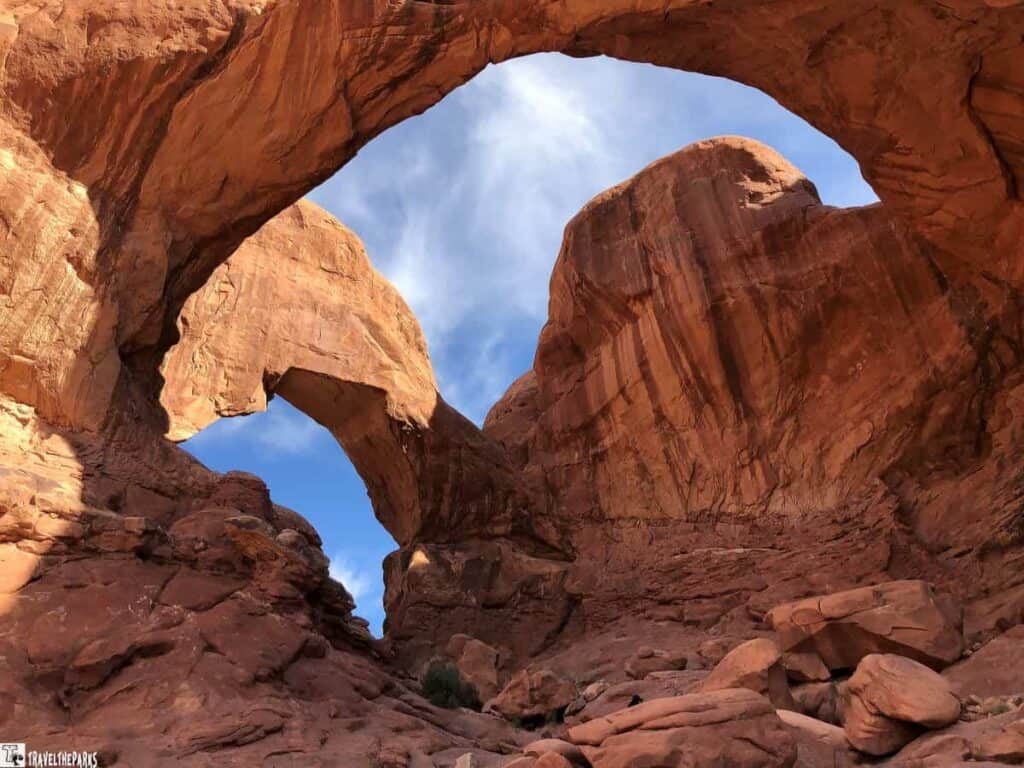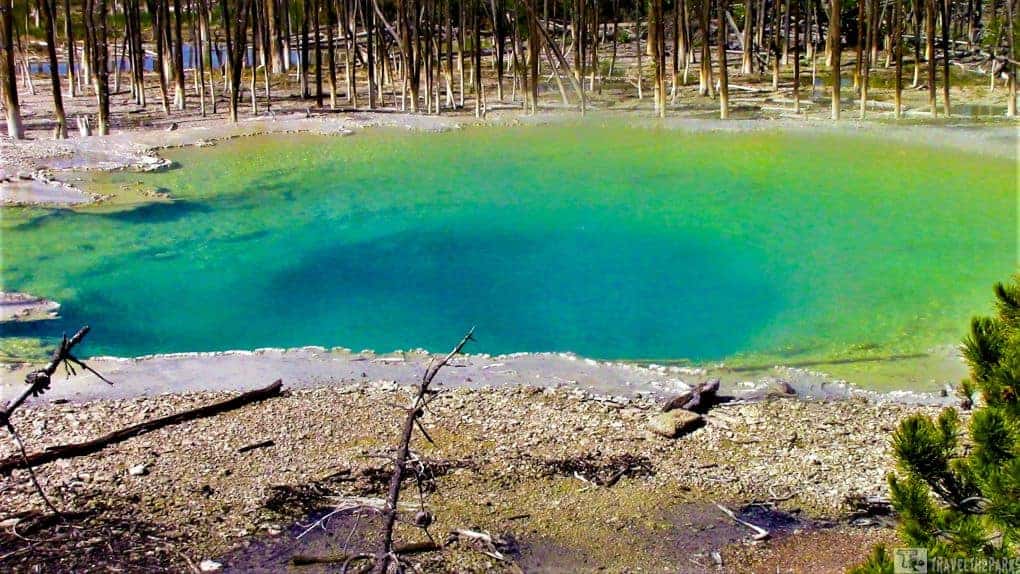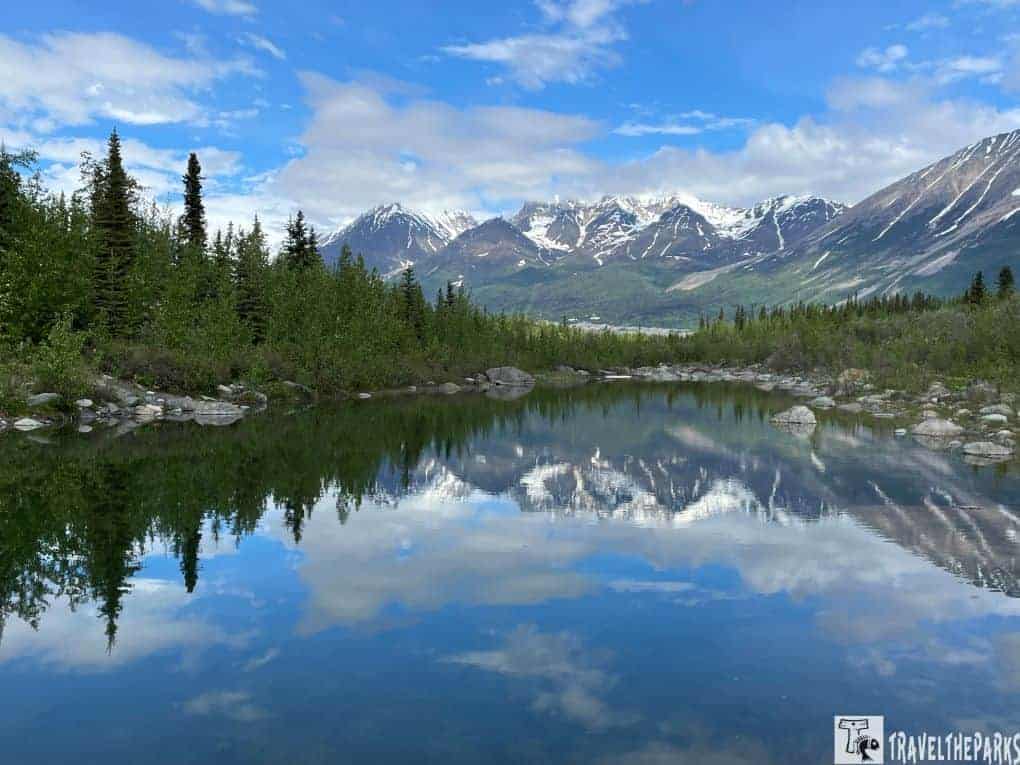Everglades National Park derives its name from the Seminole Indian word “Okeechobee,” meaning “River of Grass“. Only in Florida can you find this unique ecosystem. The rainwater drains south through the Kissimmee River system into Lake Okeechobee. The discharge from the lake slowly moves through the 60-miles of Sawgrass prairie, finally ending the journey in the Florida Bay estuary. This natural filtration system is crucial for the survival of many native species of animals and plants.
This post may contain affiliate links, meaning if you purchase something through one of these links, we may earn a small commission at no extra cost to you! Read the full disclosure policy here.

Table of Contents
About The River of Grass: Everglades National Park
Exploring Everglades National Park reveals an incredibly diverse range of ecosystems—coastal mangroves, vast sawgrass marshes, and towering pine flatwoods. While most visitors only glimpse the iconic sawgrass prairie, there’s so much more to discover if you venture deeper into the park. Beneath the surface, the life-giving waters are the true heartbeat of the Everglades—essential to every plant, bird, and animal that calls this place home. Unfortunately, these waters are in peril. Human activity remains the greatest threat to the park’s survival. To truly understand and protect the Everglades, you must go beyond the boardwalks and immerse yourself in its hidden wild places.

A slow-moving, shallow river system that flows southward from Lake Okeechobee feeds the Everglades, covering an area of approximately 4,000 square miles. This continuous sheet of water, often only a few inches deep, flows gently over the limestone bedrock, creating a unique and fragile ecosystem.

Created by Congress in 1934, dedicating it in 1946. To save this ecosystem, they created the park. The park is home to 36 threatened or endangered species, such as the Florida panther, the American crocodile and West Indian manatees. This park is unique, unlike any other National Park. The international community recognizes Everglades National Park as a UNESCO World Heritage Site, a Wetland of International Importance, and an International Biosphere Reserve. It is a globally significant ecosystem that plays a crucial role in maintaining biodiversity and providing habitat for many plant and animal species.

Its vast expanse of sawgrass marshes, shallow freshwater sloughs, mangrove forests, cypress swamps, and interconnected waterways characterizes the Everglades. The Shark Valley landscape appears as a seemingly endless grassy plain, earning it the nickname “River of Grass.”

What You Need to Know Before Visiting the Everglades
- Operating Hours: The park is open year-round, 24 hours a day, but visitor center hours are usually 8:00 AM to 5:00 PM (check specific locations for seasonal changes)
- Entrance Fees: Yes, this park charges an entrance fee. $30 per vehicle (valid for 7 days), $25 for motorcycles | $15 for individuals (biking, walking). If you are planning on visiting more than one national park, we recommend purchasing the Annual Pass ($80). It is well worth the price! We purchase our pass every year; the fees support the parks.
- Visitor Centers: Shark Valley (near Miami). Gulf Coast Visitor Center (Everglades City), Ernest F. Coe Visitor Center (Homestead). Flamingo (at the end of the main park road). Click here for the map.
- Pet Policy: Pets are allowed in parking lots and campgrounds on a leash (6 feet max). Not allowed on trails, boardwalks, or in wilderness areas.
- Best time to visit: dry season (Nov–April): cooler temperatures, fewer mosquitoes, better wildlife viewing. Wet Season (May–October): Hotter, more humid, daily storms, more mosquitoes—but lush scenery and fewer crowds.
- All the visitor centers in the park have water stations for refillable water bottles. Wear a wide-brimmed hat, polarized sunglasses, well-fitting hiking shoes, and always bring your camera along. Most important have sunscreen even in winter. The Florida sun can be brutal. You will require mosquito repellent in the warmer months.

Planning a Trip to Everglades National Park: How to Get to Shark Valley
- From Miami – Starting at the junction of SR 997 (Krome Ave) and US Hwy 41 (Tamiami Trail) west of Miami, drive 18 miles on the (US Hwy 41) to the Miccosukee Reservation. The park entrance for the Shark Valley Visitor Center is on the south side of the highway.
- From Everglades City – Take the US Hwy 41 (Tamiami Trail) east of Everglades City-Naples. Shark Valley is 45-miles through the Big Cypress National Preserve. The park entrance for the Shark Valley Visitor Center is on the south side of the highway.

Exploring Shark Valley—Everglades National Park’s Northern Entrance
We visited on Christmas Day, and the crowds seemed to overwhelm the center. By lunchtime, parking was scarce. On Christmas Day, we had to park on the shoulder of the busy Tamiami Highway-US 41. At Shark Valley, timing is key. Arrive early to avoid parking problems. At 10:30 AM, cars were already turning around and parking on the highway.
Pro Tip: The park gate closes at 5 PM. You can park outside and hike the loop trail in relative peace after hours.

Experience the River of Grass on a Shark Valley Guided Tram Tour
The primary draw for tourists to Shark Valley is the tram tour through the “River of Grass.” On our first trip to Shark Valley, we walked the entire loop. As we traversed the trail, we kept an eye out for alligators, turtles, wading birds, and other unique species that call the Everglades home. It was a tough hike—but we were younger than, and it felt like a true adventure.
PRO Tip: Purchase your tickets for the 2-hour tour at Shark Valley Tram Tour Company in advance online.
If you prefer a guided experience, you can join a tram tour that takes you along the Shark Valley Loop Trail. These narrated tours provide insights into the park’s ecology, wildlife, and cultural history. Tram tours are available for purchase at the Shark Valley Visitor Center, and they operate at scheduled times throughout the day.

Things to Do in Everglades National Park: Shark Valley Observation Tower
The heat made our choice easy: we took the tram. It was the ideal way to explore Shark Slough, spot wildlife, and learn about the Everglades. The route itself was a lesson in history, winding on a 1960s road before straightening out on a path built by an oil company in the 1940s. After several photo stops on the 15-mile journey, we arrived at the 65-foot observation tower for 20-30 minutes of stunning views.

Our guide explained that the dominant plant species in the Everglades is sawgrass (Cladium jamaicense), a tall, sharp-edged grass that grows in dense stands. These sawgrass marshes are the defining feature of the Everglades landscape and give it the appearance of a “river” of grass.

At the halfway point of the park,Climbing the tower offers a bird’s-eye perspective of the Everglades and is an excellent spot for birdwatching and photography. Climbing the tower rewarded us with stunning 360-degree panoramic views of the sawgrass prairie and scattered hardwood islands. Throughout the tour, our guide shared insights about the park’s diverse plant and animal life, pointed out key environmental features, and answered all of our questions along the way.
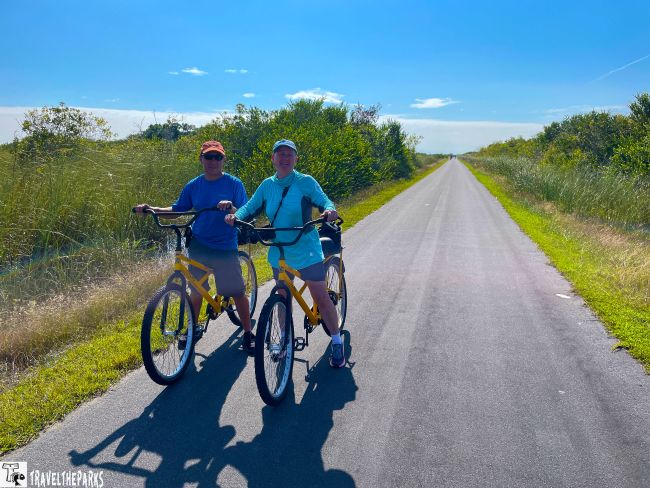
Biking the Shark Valley Loop
Alternatively, consider renting a bike and pedaling the tramroad to the observation center. The paved surface of the Shark Valley Loop Trail makes it a favored destination for bicyclists. You can bring your own bike or rent one from the Shark Valley Visitor Center. Biking the trail allows you to cover more ground and explore the Everglades at your own pace. The trail is easy to traverse as it is a flat, paved trail. I would recommend booking the tram prior to your visit if you are traveling during the peak season.

Start Your Journey at the Shark Valley Visitor Center
The educational displays inside the center provide insight into the intricacies within the various Everglades habitats. Watch the short video detailing the importance of water in this ecosystem. The center has restrooms, and the gift shop sells refreshments and shirts and other souvenirs.

What Trails are at Shark Valley?
There are two accessible walking trails close to the visitor center. The Bobcat Trail & Otter Cave Trail.
Short but Sweet: the Bobcat Boardwalk Trail
Directly behind the visitor center off the paved tram road, you will find the Bobcat Trail. Positioned beside the tram road, this is a short 0.4-mile self-guided walking trail. A tropical hardwood hammock and a sawgrass prairie are visible from the boardwalk. The trail is a good way to pass the time while waiting for your tram. In the spring, you can see nesting wading birds along the boardwalk.

Shark Valley: Otter Cave Hammock Trail
Just a 6-mile walk from the visitor center is the Otter Cave Hammock Trail. The 0.1-mile trail loops through the tropical hardwood forest. This mostly limestone trail crosses a small stream that occasionally floods the footbridges during the wet season. The rangers in the visitor center can advise you on current trail conditions.
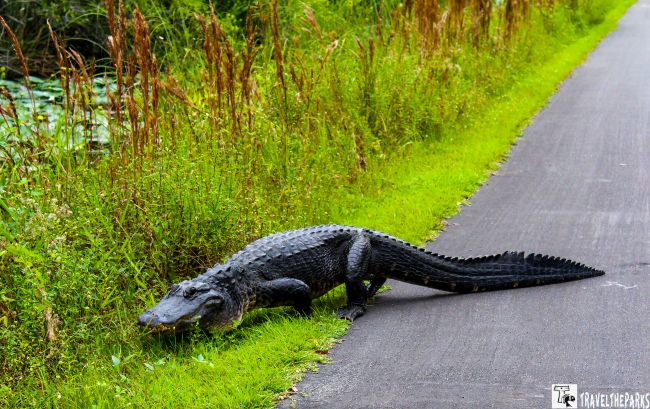
The most exciting part of getting to the trail is walking along the canal next to the paved road. The canal is just teeming with wildlife. We saw a small clutch of baby gators only a few days old. Lots of wading birds, too many to mention. Thankfully, we had ample opportunities to take great photos.
REMINDER – Always keep a safe distance of 15-20 feet when viewing wildlife and do not harass or feed wildlife. We observed many people taking risks with alligators, taking pictures way too close.

Gulf Coast Visitor Center-Northern Entrance (Everglades City)
The Gulf Coast Visitor Center is near Everglades City on Chokoloskee Bay. The visitor center is a gateway to the park’s western section, including the Ten Thousand Islands area. This area is home to a maze of mangrove islands and channels that extend along the coast to Flamingo. A unique perspective from other visitor centers. Currently, they are housing the Gulf Coast Visitor Center in a temporary trailer. Here, you can arrange boat tours, kayak rentals, and guided excursions to explore the scenic waterways, mangrove forests, and coastal habitats.

Hurricane Irma heavily damaged the original visitor center in 2017, and Hurricane Ian affected it again in 2022. There are restrooms, picnic tables, with superb views of the bay, and welcoming, knowledgeable park staff. The rangers deliver informational brochures and backcountry permits to those wishing to camp. The rangers can offer advice on approved concessionaires for boat tours, canoe rentals, or other activities. There are a few interactive educational display comparing various animal bones.
Note: The new Marjory Stoneman Douglas Visitor Center and surrounding area are currently under construction, with an expected opening in Winter 2025.
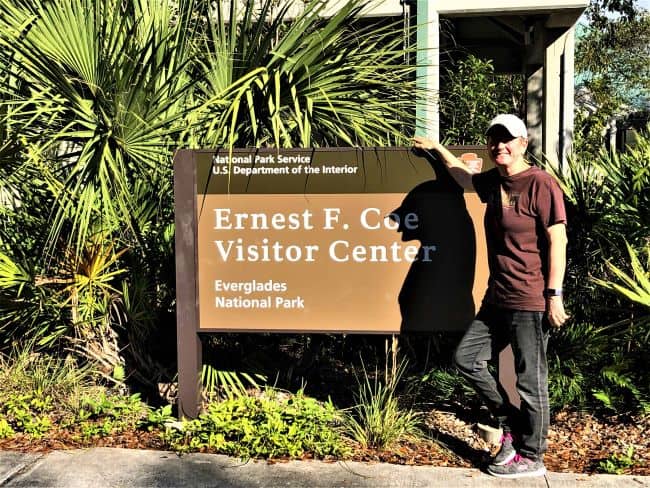
Ernest F. Coe Visitor Center-Southern Entrance (Homestead)
The Ernest Coe Visitor Center is at the main entrance to Homestead, on the road to Flamingo. Amenities at this center include a large array of educational displays and a gift store. The informational center provides maps, and in the theater, the 20-minute video can be viewed. The interactive displays help educate visitors about the entire Everglades ecosystem, providing the “Big Picture”. It is worth checking out the hiking trails and boardwalk near the pond. The verandah offers a peaceful retreat—sitting in a wooden rocking chair, simply soaking in the view is pure relaxation. Inside, the gift shop features an excellent selection of souvenirs, perfect for remembering your visit.

Everglades Flamingo Visitor Center-Southern Entrance
The Flamingo Guy Bradley Visitor Center sustained heavy damage during Hurricane Irma in 2017. During this visit, it was temporarily housed in a trailer. The old center is now repaired and open, with a new restaurant. The visitor center has educational displays and informational brochures. They post ranger-led tours daily on the board inside. Park rangers and volunteers are available to answer questions, provide maps, and offer guidance on activities, trails, and points of interest.

The park office issues backcountry permits 24 hrs a day. The rangers can provide the visitors with information on hiking trail conditions, weather advisories, and excursions. Plenty of parking, restrooms, and a small gift and a food truck. In the parking lot, we watched an osprey feeding its hatchlings. There is plenty of wildlife to see here, even crocodiles sunning themselves in the marina.
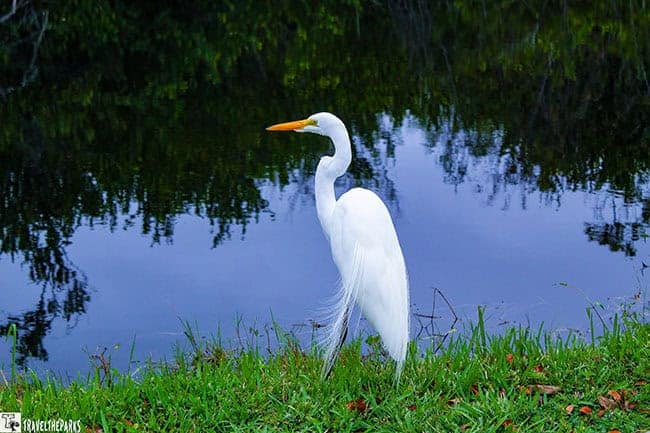
Things to Do – Everglades National Park (South Entrance)
When exploring Everglades National Park, you’ll find a wide range of activities and attractions to suit all interests. Here are some of the top things to do in the Everglades:
1. Take an Airboat Tour
As part of your Everglades National Park travel guide, an airboat tour is a must-do experience. There’s nothing quite like gliding across the water, slicing through the River of Grass with the wind in your face. These tours get you up close to alligators, birds, and other wildlife. Plus, most guides know the backcountry well, giving you great chances to spot and photograph the park’s incredible animals and plants.

They offer professional airboat tours through three authorized airboat businesses. Coopertown, Everglades Safari Park, and Gator Park are along the Tamiami Trail between Miami and Shark Valley. Airboat tours offer an exclusive experience for the visitor. Tours can range from 1 to 5 hrs, and the cost varies depending on the type of tour. Private tours being the most expensive.

2. Canoe/Kayak Eco Tour through the River of Grass
If you truly want to experience solitude in the park, try the Wilderness Waterway. The 99-mile trek traverses the park, taking 7-10 days to complete. If this adventure is not for you, there are many other shorter waterways you can trek and still find that solitude. Approved to provide tours in the park-see permitted vendors. Renting a canoe or kayak provides an opportunity for self-guided exploration of the park’s waterways. In Flamingo, you can also explore the nearby Florida Bay by kayak or canoe, or simply relax and enjoy the picturesque waterfront. We highly recommend the Nine Mile Pond Canoe Trail, which allows visitors to navigate through scenic areas and observe wildlife at their own pace.

3. Fishing in the Everglades National Park
There are many opportunities to fish in the park, whether in freshwater or saltwater. Before you fish, it’s important to familiarize yourself with the fishing regulations and license requirements. The Everglades National Park follows Florida state fishing regulations, and a valid Florida Fishing license is required for anglers aged 16 and older. There may be specific rules regarding bag limits, size restrictions, and seasonal closures for certain species, so it’s essential to check the latest fishing regulations to ensure compliance. Check with the ranger for fishing regulations or closed zones.
The freshwater fishing in the Everglades primarily centers around its numerous rivers, canals, and freshwater marshes. Common freshwater fish species include largemouth bass, bluegill, black crappie, and various species of catfish. Anglers can fish from the shore or bring their own boats or canoes to explore the waterways. It’s important to note that some areas may have motor restrictions or require permits for certain activities. December is prime time for bass fishing. When we were there, many fish species were spawning. We watched, saw some male bass guarding beds, and others actively courting.

Hiring a guide for saltwater fishing is best at any time of the year. Navigating the many waterways in the park can be difficult. Storms and hurricanes often damaged many of the navigation markers. For those wishing to fish freshwater, there is not much accessible shoreline. Having a boat or hiring a guide is best. A fishing regulations PDF is available at this link: click here.
Exploring Everglades National Park Saltwater Fishery
Everglades National Park encompasses a significant portion of Florida Bay, offering excellent opportunities for saltwater fishing. Anglers can target a wide range of species, including snook, redfish, spotted sea-trout, tarpon, and various types of snapper and grouper. You can fish from the shore, wade in shallow waters, or use a boat. It’s worth noting that certain areas within the park, particularly those designated as marine reserves or protected zones, may have specific fishing restrictions or closures.

4. Scenic Boat Tours of the Backcountry or Florida Bay
Flamingo Boat Tours, in the southern part of the park, serves as a hub for various boat tours. These tours typically explore the mangrove forests, coastal areas, and Florida Bay. They offer opportunities to spot manatees, dolphins, a variety of bird species, and other marine life. Some tours also include stops at remote islands for beachcombing and snorkeling.
5. Hiking and Nature Trails in Everglades National Park
The Everglades provides a variety of hiking trails suitable for different fitness levels. From short boardwalk trails like the Anhinga Trail and the Gumbo Limbo Trail to longer trails like the Shark Valley Loop or the Coastal Prairie Trail, there are options for everyone to experience the park’s diverse landscapes.

Where to Camping in the Everglades National Park
Everglades National Park offers plenty of camping opportunities. Long Pine Key and Flamingo both have campgrounds for RV or tent campers. A picnic table and fire ring are available at each campground site. Mosquitoes are problematic throughout the year, to bring DEET repellent!

Long Pine Key Campground: Nestled in the River of Grass
The campgrounds are approximately 6-miles from the Ernest Coe Visitor Center. These sites are large, with paved pads for RVs and grassy areas for tent both surrounded by dense foliage. They allow you to make reservations online or by phone (1-855-708-2077) for one of the 108 sites. The campground offers both tent and RV sites. The sites are spacious and well-spaced, providing a sense of privacy. Each site has a picnic table, grill, and access to shared restrooms with flushing toilets and running water. However, there are no electrical hookups available at the campground. The restrooms are clean, with lukewarm running water for showers. There was also a ranger-led evening program at the amphitheater that was interesting.
NOTE: There are no hookups for RVs.
Long Pine Key Campground provides access to various outdoor activities in Everglades National Park. There are hiking trails nearby, such as the Long Pine Key Nature Trail and the nearby Pineland Trail, which offer opportunities to observe wildlife and explore the park’s ecosystems. Bicycles are also allowed on some of the park’s roads, providing an alternative way to explore.

Stay at the Flamingo Campground in Everglades National Park
The campground is located 38 miles from the southern entrance to Everglades National Park, near the Flamingo Visitor Center. It offers convenient access to various trails, waterways, and attractions within the park. Flamingo Campground offers both tent and RV sites. The tent sites are typically more secluded, surrounded by vegetation, and offer a more rustic camping experience.
The site is essentially an open grassy field. Clean restrooms, a bathhouse and showers with HOT showers are in the tent area–courtesy of the newly installed solar panels. RV sites had electrical outlets available, but no water hookups. Water fill-up is beside the dump station, restrooms. The campground is close-proximity to the marina, store and visitor center. The new park concessioner is now accepting reservations through Flamingo Adventures, or by calling 855-708-2207.

Camping at Flamingo Campground opens up a world of outdoor activities when exploring Everglades National Park. You can discover hiking trails, such as the Coastal Prairie Trail and the Eco Pond Trail, to discover the park’s unique flora and fauna. Be prepared for the subtropical climate, pack insect repellent, and follow park guidelines to ensure a safe and enjoyable camping experience at Flamingo Campground.
NOTE: Be forewarned, there is NO cell phone service or gasoline!!! Bring all the supplies for your trip with you. There are limited services available.

Unique Eco-Tent Camping in Everglades National Park
Eco-tent camping is a sustainable and environmentally friendly way to experience the outdoors while minimizing your impact on the environment. New to the Campground are Eco-tents. Most people would refer to these as “glamping.” Canvas-sided Eco-tents are set on platforms. Equipped with a comfortable bed, a fan, electrical power outlets and lighting. A raised boardwalk connects each safari-style tent (Eco-tent), each offering a wonderful view of Florida Bay. Most disappointing was the lack of food preparation. Here you can either eat at the marina or use the grills and tables in the common camping area. The store isn’t cheap, but I can see why it appeals to some campers.

The Flamingo Lodge at the southern end of Everglades National Park is now open again. The eco-lodge has 24 rooms and is made from old shipping containers. Thirteen-foot-tall concrete supports hold up the lodge. This makes it tough enough to withstand bad weather. The design clearly aims to help the environment. It combines comfort with environmentally friendly features. Guests can appreciate the beauty of nature while being aware that the lodge takes care of the environment. The lodge is designed to be eco-friendly and strong, making it suitable for a challenging natural environment.
Everglades National Park also allows backcountry camping for those seeking a more remote and immersive experience. Permits are required, and campers must follow specific guidelines and Leave No Trace principles. The park offers designated camping zones accessible by canoe, kayak, or on foot, providing opportunities to explore and camp in more secluded areas. Within the park’s backcountry, there are unique camping structures called chickees. These elevated platforms with roofs are located along waterways, providing a rustic camping experience. Visit the backcountry website for proper planning.

Other Lodging Available: Everglades National Park the River of Grass
A few years back, when we first explored Everglades National Park, I remember there was a hotel with a few cabins. After Hurricane Wilma in 2005, it was closed. The new Flamingo Lodge offers comfortable accommodations right inside Everglades National Park. With modern amenities, easy access to trails, boating, and wildlife viewing, it’s the perfect base for exploring the park’s unique ecosystems. Besides camping options within Everglades National Park, there are various lodging options available in the surrounding areas.
However, there are abundant accommodations in nearby Homestead or Florida City. Staying here provides easy access to the Everglades, Biscayne National Park, and the Florida Keys and Dry Tortugas National Park.

Best Western Gateway (Homestead)
Homestead and Florida City, on the northeastern edge of Everglades National Park, offer a range of lodging choices, including hotels, motels, and vacation rentals. These towns serve as convenient bases for exploring both the national park and the nearby Biscayne National Park.
We opted to stay at the Best Western Gateway to the Florida Keys, only 10-miles from Everglades National Park. The room was clean and spacious, featuring a table with two chairs, a sofa, a coffeemaker, a refrigerator, and a microwave. Our breakfast was outstanding, offering scrambled eggs and bacon, toast, waffles, yogurt, fresh fruit, cereal, bagels, and assorted pastries. Fresh coffee was always available. The staff was very helpful, and the inviting pool was a perfect place to relax.
This hotel is close to many restaurants. For us, being Christmas Day, the only open restaurant was IHop. The food and service were amazing, considering the number of customers coming and going.

Everglades City Motel – Everglades Adventures Inn
Many vacation rental properties can be found in the towns and cities surrounding the Everglades, such as Naples, Homestead, and Everglades City. Platforms like Airbnb and VRBO list a range of vacation homes, condos, and apartments that provide a home-like experience during your visit.
Spotless, but the room was small. While the exterior looks like a standard old building, our newly renovated motel room was much more upscale than we expected. Furnishings were minimal. However, the plush bedding and new bathroom shower were very large with soft plush towels. Nothing fancy. We found the walls to be paper thin. There is a refrigerator, microwave, and a coffeemaker. Next door is the Island Cafe restaurant, and a short distance past that is a gas station with a small general store. For this reason, they met our expectations. If I were to return to the area, I would gladly stay there again.
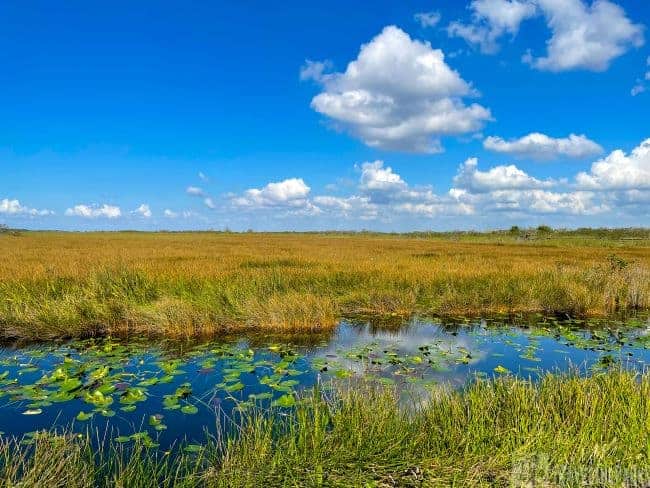
Make Time for Robert is Here Fruit Stand
One of the most famous places, a must-do, is a stop at Robert Is Here-Fruit Stand. Not your ordinary fruit stand for sure. We always make time to stop in for their smoothies. They are absolutely amazing. They are just so delicious. Each is freshly made from a variety of fresh fruit choices. For the kids, let them visit and feed the animals in the back petting zoo. We always sit and watch the interactions while enjoying our smoothies. They sell top produce, sandwiches, assorted jellies, sauces and other specialties. This place is iconic, not a tourist trap but an institution, so make the stop!

Planning Resources, Everglades National Park Area
- Everglades National Park website: for planning your visit in the park.
- Flamingo Boat Tours and Rentals: book ahead of time.
- Shark Valley Tram Tours: these tours fill early, so plan ahead
- Lodging in Florida City/Homestead Area
- Accommodations Everglades City Area
- Big Cypress National Preserve: Although not part of Everglades National Park, the Big Cypress National Preserve is next to the park and offers additional opportunities for exploration. Take a scenic drive along the Tamiami Trail, hike one of the trails, or embark on a swamp walk to see the unique flora and fauna of the region..
- Fakahatchee Strand State Park: home of the elusive Florida panther and Ghost orchid. Hiking trails in an “Old Florida” swamp habitat.
- Collier-Seminole State Park: the park provides a variety of outdoor activities for visitors to enjoy. There are several trails available for hiking and nature walks, where you can explore the unique plant and animal life.

Final Thoughts-Exploring Everglades National Park, the Fascinating River of Grass
The Everglades is a delicate ecosystem that relies on a delicate balance of water flow and natural processes. It faces many challenges, including habitat loss, invasive species, pollution, and water management issues. Exploring the park reinforces the importance of conservation efforts and the need to protect this unique landscape for future generations.

One cannot ignore the sense of peace that washes over you when exploring the Everglades. Far away from the hustle and bustle of urban life. It’s a natural sanctuary, offering a chance to reconnect with nature and find solace in its serene beauty. We thoroughly enjoyed our visit to the Everglades. We normally visit the Glades frequently. The sight of a gator never disappoints. I must say, exploring the “River of Grass” is a fascinating experience.
Have you journeyed to the River of Grass? Tell us about your adventure in the Everglades. Share in the comments below.

